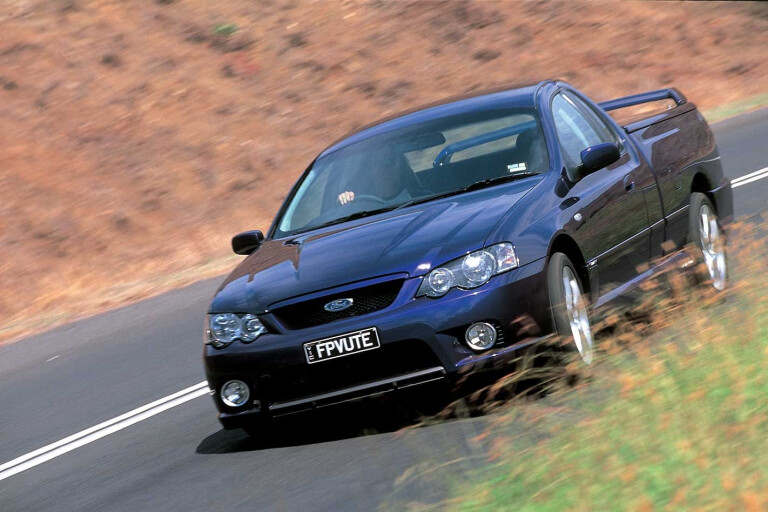
I’m not exactly sure what Falcon GT buyers will think of Ford’s decision to sling the storming 290 kW mill into the BA Ute. At least the Broady Boys have resisted the urge to call it a GT Ute, but even the Pursuit badges can’t hide the fact that the thing is every bit as musclebound as the pukka GT.
This review was originally published in MOTOR’s May 2003 issue
“So doesn’t the full-welly ute devalue the GT a bit?” I asked a Ford insider.
“Hope not,” he said. Hmmmm.
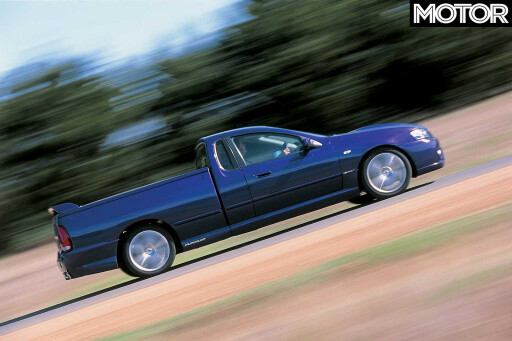 Observe, meanwhile, that HSV does not, repeat not, do a 300 kW version of the Maloo (it’d be a horrific gadget, probably) and that Ford never did a GT HO version of its hay-hauler back in the XW/XY days. Oh sure, you see plenty of 351-donked, shaker-bonnetted XY utes now, but they’re all the work of Gino and his mates.
Observe, meanwhile, that HSV does not, repeat not, do a 300 kW version of the Maloo (it’d be a horrific gadget, probably) and that Ford never did a GT HO version of its hay-hauler back in the XW/XY days. Oh sure, you see plenty of 351-donked, shaker-bonnetted XY utes now, but they’re all the work of Gino and his mates.
But even if you ignore the marketing stuff (and I’m happy to see that happen) doesn’t the idea of a 290 kW Falcon Ute seem just a bit off-putting?
Depends how you look at it, probably, because on one hand there’s the knowledge that the engine punches out about 390 horsepower in the old money and shuffles it back to a leaf-sprung live axle. Now, slippery diffs and sticky tyres notwithstanding, that’s a big ask of a rear end that featured heavily on Noah’s first boat trailer. On the other, less up-itself hand, you can never have too much grunt.
The truth of that theory goes up in smoke – literally – the first time you try to launch the Pursuit for a quick 400m time. Even with less than 2000 rpm showing on the tach, treating the clutch with anything less than total respect will have the bags howling and the rear slewing sideways. And the clock ticking. Best we could do with plenty of runs was a 14.4 which seems a bit off the pace on face value, but is more explainable when you look at the Ute’s weighbridge ticket.
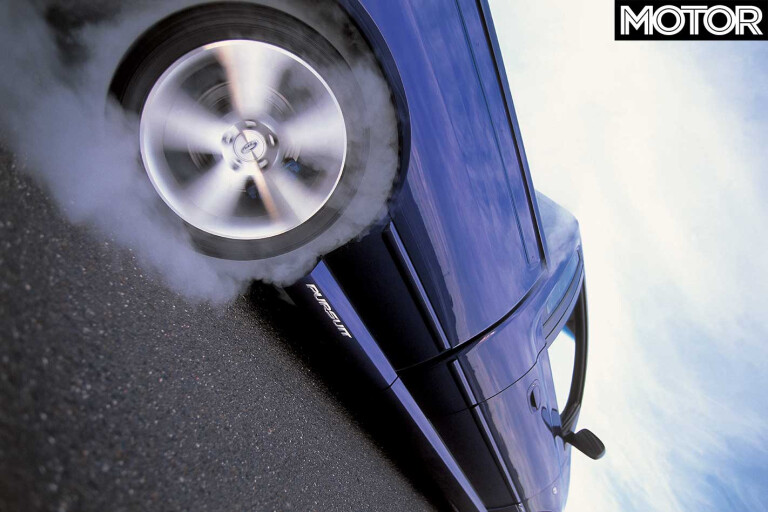
Let’s not beat around the bush, the BA is a Fatty Boom-Sticks. It gives about 200 kg away to the equivalent Holden (or HSV) sled and, as anybody will tell you, even 100 kg is worth about half a second, maybe more. Frankly, I reckon you can put down the glasses now: Until Ford checks Barra into Jenny Craig, you can forget a sub-14 quarter.
But what those figures don’t tell you is just how good the GT mill feels on the road. And it starts from the moment you fire up the big, DOHC Henry. Assuming you can, that is. See, firing the Pursuit up is not easy the first time. In fact, it’s damn impossible until you figure out that the little button on the dashboard hiding behind the steering wheel is actually the starter button. Arrrgh.
I asked a different FPV insider who’s dickhead idea that was.
“The boss’s, actually.”
“Oh.”
“Yes, apparently Mr Flint has always wanted to build a car with a starter button. It’s something to do with his time at Aston Martin, we think.”

Flinty, mate… stop it at once. A Falcon ute (for that is what it is) needs a starter button like James Bond needs a blue singlet and a girlfriend called Shazza.
Anyway, once you get her idling (the Falc’, not Shazza) you soon find that there’s enough torque down low to be convincing and a real smoothness (crap idle aside) that lasts all the way to 6000 rpm.
The big trick up the Pursuit’s sleeve, however (over the XR8, anyway) is the bullet up the bum at about 3650 rpm. While it feels strong up to that point, it suddenly comes over all raunchy and starts making deeper, gruffer noises as well as winding in the scenery with an authority that most of us red-blooded types will find entirely addictive.

It lasts, too, all the way to the cut-out and for the nearly two-and-a-half thousand rpm where it’s really hauling, it’s as good as you’ll find this side of $200,000.
Less brilliant is the gearshift which, while better than the T5 in the XR6, still falls way short of slick. It can be hammered home quickly, but it feels brutal to do so and even then, the two-three shift takes a relative eon.
Plenty has been written about the loss of steering feel in the transition from AU to BA, and the Pursuit is no different. Yeah, the newie’s tiller has more weight than the AU’s ever had, but the quantity and quality of info coming back through the MOMO is seriously diminished.
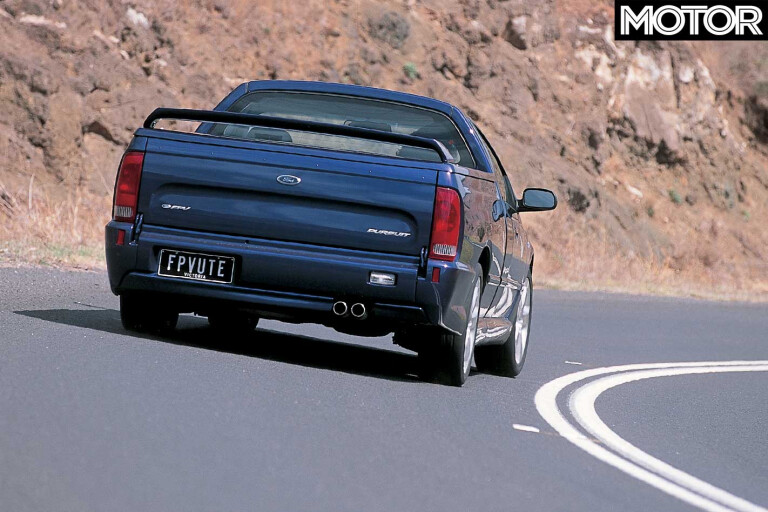
It remains, however, and despite the bulk mumbo, pretty hard to get out of shape on a smooth surface, and that’s mainly due to the wheelbase measured in furlongs. You’ll need a tight-ish corner and loads of right clog to get it sliding and even when it does, you can pretty much hold it out there long enough to send a few postcards from the edge.
Bumpy roads, on the other hand, dredge up a whole new personality. Not sure whether the front end is a bit prone to bump-steer or just some simple tramlining, but the nose will wander over bumps and follow contours, especially under brakes.
The axle under the tray, meanwhile is even more recalcitrant and the combination of its being tied down tighter than it might be and the relative crudity of the technology means it simply doesn’t cope too well when things hot up.
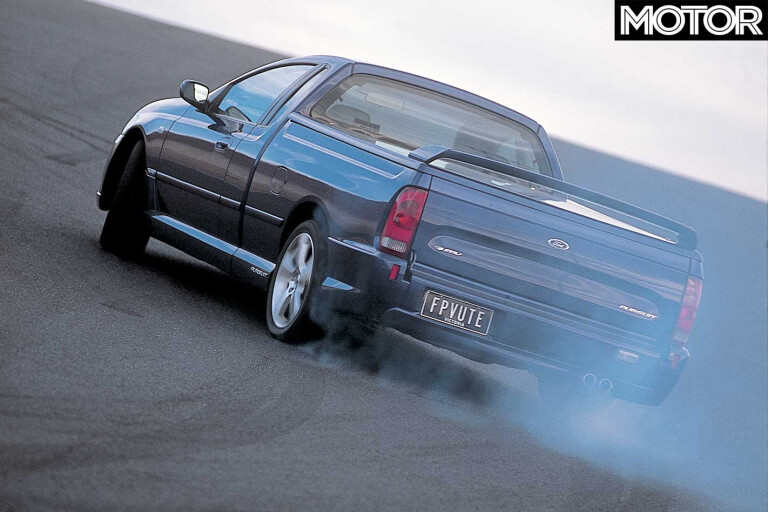
Downhill, off-camber bumps really test the rear and under those conditions it starts to hop about and shuffle its feet a bit. You get the feeling that it’s only the grippy (and wide) Dunlops that save the day. Turn the trip around and tackle the same off-camber bumps uphill and the Pursuit projects a less threatening persona, but still can’t match a BA sedan’s squat-and-squirt behaviour.
The big surprise is that the ride is vastly better than it should be given the spring rates and technology. Maybe it’s all that wheelbase (again) but the Pursuit rides like about 50 per cent better than you expect it to. Which means about 100 per cent better than the AU range of Ford hotties.
So, while it doesn’t have the outright unflappability of the GT sedan, for the majority of the time you’d never know it and, thanks to the ride quality, you mightn’t even miss it.

Standard brakes on the Pursuit are Ford’s Premium package with 325 mm rotors and twin-spots up front with 303 mm solid discs and single-spots out back. They seem to have that nice knack of giving you just the retardation you think you’ve dialled in with good pedal feel all the way. And if our dragstrip experience is representative, fade isn’t something you’re going to be worried about. All of which makes the optional Brembo package marginal for most buyers.
Inside, there’s a bit of leather and swanky suede trim, although exactly how a suede armrest will cope with a year’s worth of brickie’s sweat is anybody’s guess.
The rest is straight GT, and on the outside, the bodykit is amazingly easy to live with in terms of clearance and approach angles. What it isn’t is subtle and the rather fussy front end treatment is matched by a rear apron that looks heavy and overdone. Throw in the bonnet bulge and the Pursuit looks to be trying a bit too hard from some angles. It is, however, impossible to ignore.
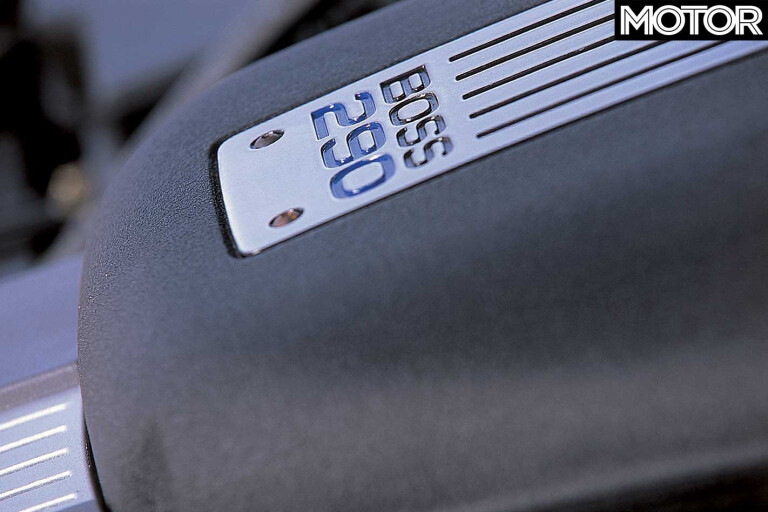
Annoying aspects include the hard tonneau which restricts carrying anything deeper than the tray sides (okay, the tonneau is removable) but more than that needs to be locked twice with a fiddly, cranky key (once on each side). And a spoiler on a ute? Nah, don’t think so.
I’m also affronted by the placement of the starter button (and its existence in the first place) that makes starting a two-handed affair.
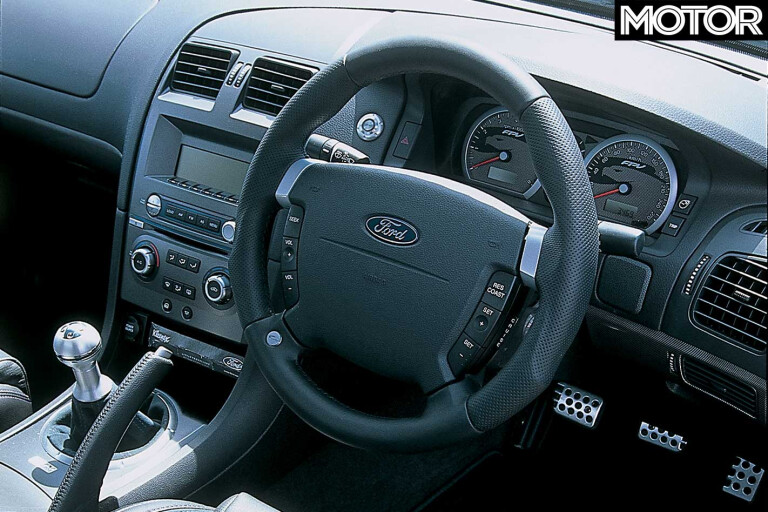
And while we’re at it, can we please have a bit more travel on the throttle-by-wire gas pedal? As it is, it feels like there’s about an inch between idle and flat-chat. It imposes no practical problems, but it feels strangely unsatisfying.
The Pursuit’s biggest problem is that it’s no longer as good (or better in some ways) as a Falcon sedan. Of course, that’s mainly because the sedan has evolved such a long way over the AU, while the ute, 290 kW notwithstanding, has simply not come as far in the transition from AU to BA. This, however, is unlikely to bother the self-made blerks who are likely to throw $55-large at a light commercial.
And good on ’em.
The Beginning

While Ford finally woke up to itself in 1992 and dusted off the old Windsor five-litre V8 for the sedan range, it took another age before the ’umble Falcon Ute was eventually fitted with the bent-eight.
It first reappeared in 1997 in XH Ute form a few years after Ford had re-engineered the whole vehicle’s front end to accept the overhead camshaft six of the sedan.
Of course, Ford might have given buyers the chance to tick the ‘V8’ box, it hadn’t actually spent squat on making the motor any more exciting than the boat anchor it most assuredly was. We wound up with the ridiculous situation of having the standard six-potter Ute making 148 kW and the V8 capable of just 17 more for a grand total of 165 kW.
Even the torque wasn’t significantly hiked over the six, and a lot of people just couldn’t see the point, especially when the Ute itself was still heavily based on the XD model of 1979.
But there was some better news. And that was the XR8 Ute.
With 185 kW and 402 Nm it still wasn’t the engine it might have been (the Windsor was eventually stretched to 5.6 litres and 250 kW for the last of the AU sedans and hay haulers) it did put a rocket up
the bum of the relative lightweight XH Ute bodyshell.
Significantly, it was enough of an advance over the six to be worth the bother and with the quad-headlight styling and other XR8 bits, it set Ford on the path that has led it to this point and the Pursuit.
Nice one, Grandad.
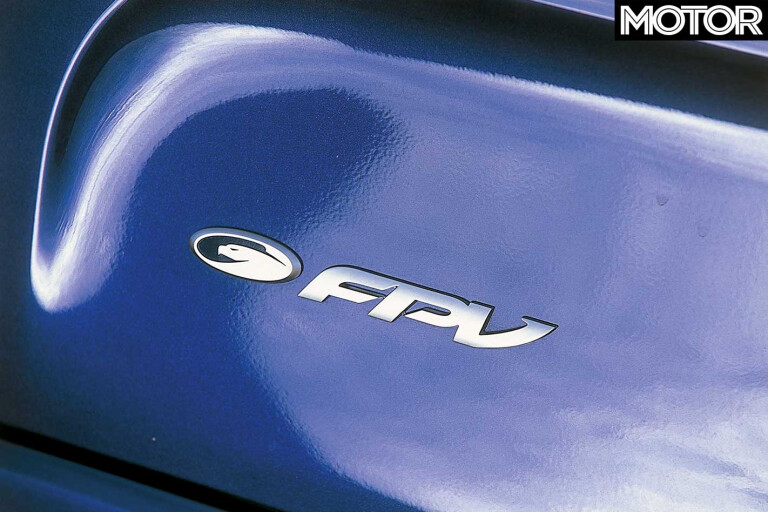
FAST FACTS
FPV Pursuit 290
BODY: 2-door ute
DRIVE: rear-wheel
ENGINE: 5.4-litre, DOHC, 32-valve V8
BORE/STROKE: 90.2 mm x 105.8 mm
COMPRESSION RATIO: 10.5:1
POWER: 290 kW @ 5500 rpm
TORQUE: 520Nm @ 4500 rpm
WEIGHT: 1870 kg
POWER-TO-WEIGHT: 155kW/tonne
TRANSMISSION: five-speed manual
SUSPENSION: double wishbone, coil springs (f); live axle, leaf springs (r)
L/W/H: 5123/2141/1435 mm
WHEELBASE: 3095 mm
TRACKS: 1560 mm (f); 1575 mm (r)
BRAKES: 325 mm grooved, ventilated discs, two-piston calipers (f); 303 mm grooved, solid discs, single-piston calipers (r)
WHEELS: 18 x 8-inch (f & r), alloy
TYRES: Dunlop SP Sport 9000, 235/45 R18 (f&r)
FUEL: 68 litres PULP
PRICE: $54,850
FAST FIGURES
0-100km/h: 6.02sec
0-160km/h: 14.31sec
0-400m: 14.43sec @ 162.5km/h

COMMENTS